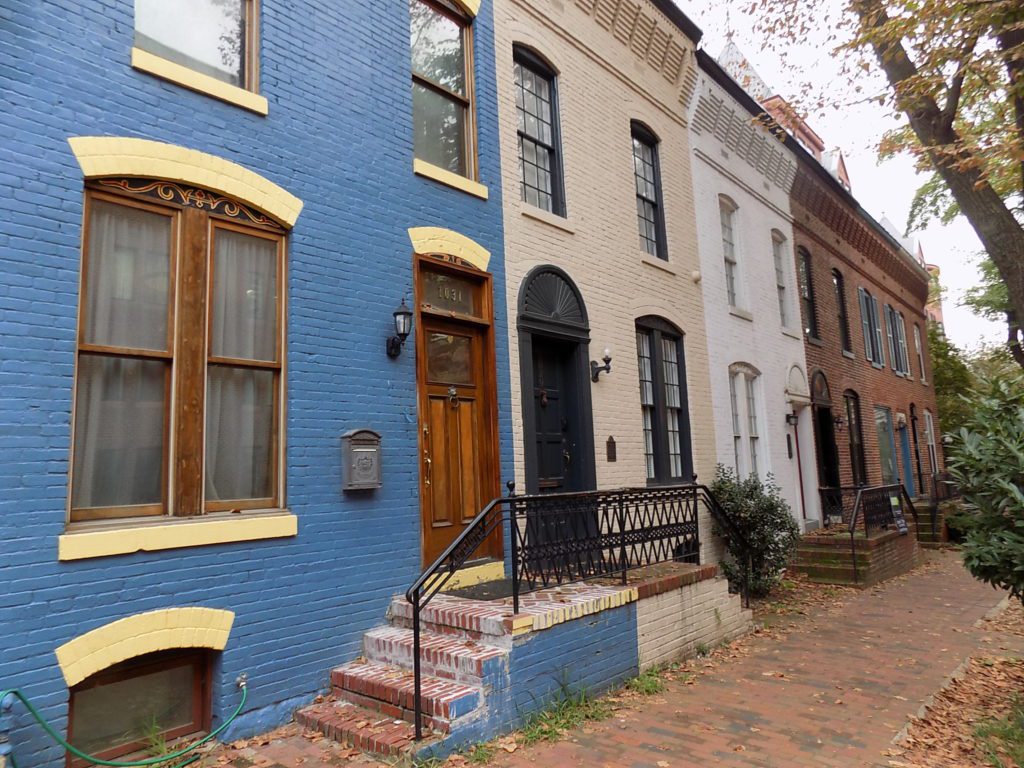By Alison Schafer
The work of the Foundation for the Preservation of Historic Georgetown reaches from the quaint little cottage down the street to the giant Beaux-Arts mansion high above the Potomac. The round gold plaques such houses wear on their facades are a testimony to the owners’ — or perhaps the previous owners’ — desire to preserve Georgetown’s historic appeal.
In 1950, on Georgetown’s 200th birthday, Congress created the Old Georgetown Act to protect and preserve the historic fabric of the neighborhood. It was the first historic district in D.C. and only the sixth in the nation.
But by the mid-1960s, historic houses were being demolished and new buildings were popping up on open spaces. Commercial buildings were creeping onto residential streets. In response, a group of worried Georgetowners created the Foundation for the Preservation of Historic Georgetown.
Easements are, or used to be, one of FPHG’s main preservation tools. Since the late 1960s, the nonprofit foundation has been granted easements on 110 properties in the Georgetown Historic District.
Potential homebuyers, locals and tourists walking around the neighborhood can tell which houses are under easement to FPHG. Easement buildings wear round gold plaques on their facades. An easement gives the foundation an interest in land or a building owned by someone else. The foundation exists to protect the integrity ofproperties under easement, so your nice new neighbor can’t raze her 18th-century Federal house and replace it with a Brutalist high-rise.
Needless to say, without FPHG, Georgetown would look substantially different, and not nearly as historic. But the work is changing. As FPHG President Peter Jost notes:“Today, changes in the tax rules have caused a reduction in the interest of donors to grant historic preservation easements. As a result, FPHG is undertaking other preservation steps, such as contributing funds to preserve Tudor Place and restoreMt. Zion Cemetery.”
Mt. Zion is a historic cemetery on 26th Street, abutting Rock Creek Park. Founded in 1808, it served a mostly African American population, and is the burial ground for members of the Female Union Band Society. It was abandoned in the 1950s and neglected for decades. Now the foundation is working to clean it up and return some dignity to the lovely but neglected space.
FPHG has also been instrumental in navigating the sometimes fraught relationship between the two famous Georgetowns: the university and the neighborhood it occupies. The foundation has acted as a bulwark against the expansion of the university into residential areas.
Because the foundation is invested in preservation, some of its tasks take placeaway from the neighborhood’s busy streets and brick facades. Working with the Historic American Buildings Survey, FPHG is using large-format photographs and drawings to document the properties with easements. These will be put in the permanent collection of the Library of Congress.
Not just about the past, FPHG is about life in Georgetown right now. Andpreservation isn’t anti-change, it is about creating a community with its roots — and facades and wrought-iron bannisters and wooden doors — in the past, but with its inhabitants focused on the future.
“The work of FPHG fosters a vibrant community honoring its traditions andarchitecture, benefiting both residents and visitors,” said Celia Lovell, a foundationtrustee. “In my 40-plus years of living in Georgetown, I’ve found that the physical characteristics of the area support and encourage personal interactions and neighborliness. Block by block, and perhaps dog by dog, we meet our neighbors, talk on the sidewalk and often gather to celebrate whatever might be available tocelebrate.”
FOUNDATION FOR THE PRESERVATION OF HISTORIC GEORGETOWN
Box 3603 Georgetown Station
Washington, DC 20007
info@preservegeorgetown.org
Peter H. Jost,
President
Chiswell D. Langhorne Jr.,
Treasurer
John A. Hodges,
Secretary


